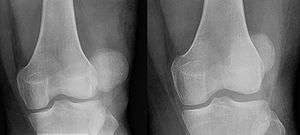Luxating patella
| Luxating patella | |
|---|---|
 | |
| Patella luxation on radiograph. Left before, right after reduction. After reduction the patella is still displaced. | |
| Classification and external resources | |
| Specialty | rheumatology |
| ICD-10 | M22.1 |
| ICD-9-CM | 836.3, 836.4 |
Luxating patella (or trick knee, subluxation of patella, floating patella, or floating kneecap) is a condition in which the patella, or kneecap, dislocates or moves out of its normal location.
Patellar luxation is a common condition in dogs, particularly small and miniature breeds. The condition usually becomes evident between the ages of 4 to 6 months. It can occur in cats as well, especially the Domestic Shorthair.[1]
It also occurs in humans, where it can be associated with damage to the anterior cruciate ligament.[2]
Presentation
Most cases of patellar luxation are medial and this is frequently a congenital problem in toy and miniature breed dogs. Breeds showing a predisposition for medial patellar luxation include miniature and toy Poodles, Maltese, Jack Russell Terriers, Yorkshire Terriers, Pomeranians, Pekingese, patterdale terrier, Chihuahuas, Cavalier King Charles Spaniels, Papillons, Boston Terriers, Plummer Terriers and Teddy Roosevelt Terriers. Large breed dogs are also affected and the Labrador retriever seems particularly predisposed. Patellar luxation is less common in cats than in dogs. Predisposed breeds include the Devon Rex and the Abyssinian. Although the specific cause of patellar luxation is unknown in these cases, it is generally agreed that a defect in hind limb conformation is the underlying cause.[3]
Causes
Rarely, it can be caused by some form of blunt trauma, but most frequently, it is a developmental congenital defect. In congenital cases, it is frequently bilateral. The condition can also be inherited through genetics. This can also be caused by obesity.
Diagnosis

Diagnosis is made through palpation of the knee, to see whether it slips inside the joint more than would normally be expected. Often a dog owner might be told that his or her pet has "loose knee", but this is not a medical term, and it is not correct to use it interchangeably with luxating patella.[4]
Luxating patella cannot be present without the knee being loose, but a loose knee is not necessarily slipping out of the joint. Even with luxating patella symptoms such as intermittent limping in the rear leg might be mild or absent. Physical examination and manual manipulation are the preferred methods for diagnosis. More extreme cases can result in severe lameness. Osteoarthritis typically develops secondarily.[4]
The four recognized diagnostic grades of patellar luxation include, in order of severity:[4]
Grade I
- Grade I - the patella can be manually luxated but is reduced (returns to the normal position) when released.
Grade II
- Grade II - the patella can be manually luxated or it can spontaneously luxate with flexion of the stifle joint. The patella remains luxated until it is manually reduced or when the animal extends the joint and derotates the tibia in the opposite direction of luxation.
Grade III
- Grade III - the patella remains luxated most of the time but can be manually reduced with the stifle joint in extension. Flexion and extension of the stifle results in reluxation of the patella.
Grade IV
- Grade IV - the patella is permanently luxated and cannot be manually repositioned, with up to 90° of rotation of the proximal tibial plateau. The femoral trochlear groove is shallow or absent, with displacement of the quadriceps muscle group in the direction of luxation.
Treatment
Grades II, III and IV require surgery to correct, if the animal has difficulty walking. The surgery required is governed by the type of abnormality present, but often involves a sulcoplasty, a deepening of the trochlear sulcus that the patella sits in, a re-alignment of the attachment of the patella tendon on the tibia, and tightening/releasing of the capsule either side of the patella, according to which side the patella is slipping. Some Grade IV conditions may require more involved surgery to realign the femur and/or tibia.
Additional help can be given with the use of pet ramps, stairs, or steps. These can help the animal travel from one place to another, especially up and down, without adding any pain or damage to the patella.
External links
References
- ↑ Ettinger, Stephen J.; Feldman, Edward C. (1995). Textbook of Veterinary Internal Medicine (4th ed.). W.B. Saunders Company. ISBN 0-7216-6795-3.
- ↑ "The Knee and Shoulder Centers - [PRINTABLE] Anterior Cruciate Ligament Surgery". Retrieved 2007-11-27.
- ↑ Patellar Luxation, canine and feline (cat and dog) veterinary factsheets
- 1 2 3 OFA. "Patellar Luxation". Orthopedic Foundation for Animals. Archived from the original (text/html) on 2007-08-26. Retrieved 2007-09-04.